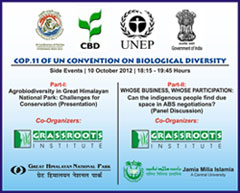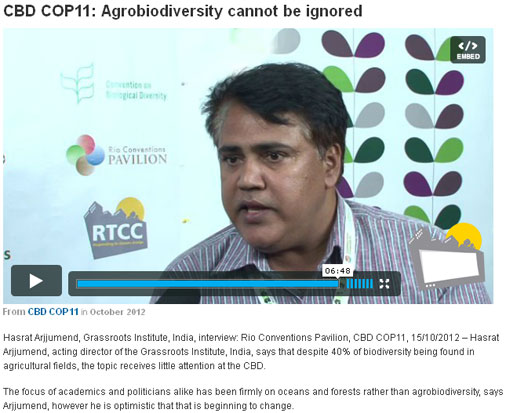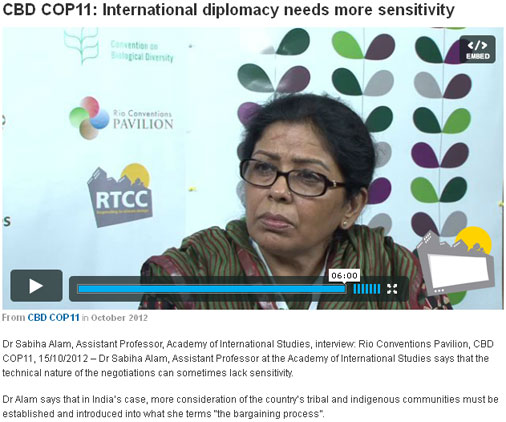|
| |
| DISCOURSE & PARTICIPATION |
|
| |


Side Event in COP11 of
UN Convention of Biological Diversity
Hyderabad India International Convention Centre | 10 October 2012 | 18:15 - 19:45 Hours
|
Part-I: Agrobiodiversity in Great Himalayan National Park: Challenges for Conservation (Presentation)
Chair: Dr. Krystyna Swiderska, Senior Researcher, Agriculture and Biodiversity, IIED London
Co-Chair: Dr. Ingeniero Alejandro Argumedo, Country Coordinator, ANDES – Asociacion Kechua-Aymara para Comunidades Sustenables, Peru
Speakers: Mr. Hasrat Arjjumend and Chuni Lal, Grassroots Institute
Great Himalayan National Park, situated in Kullu district of Himachal Pradesh, India, is home to huge diversity of fauna and flora. Having rich bio-cultural traditions the farmer communities residing in buffer zone of GHNP have developed multitude of indigenous on-farm techniques (the methods by which inputs are powered) and technologies (the application of knowledge to the production system) for optimal production. Appreciable diversity of agriculture has been maintained through a variety of crop compositions, cropping patterns and crop rotations. Grassroots Institute (research and training set up of Grassroots India Trust, a national NGO) undertook the mapping, characterization and documentation of in situ agro-biodiversity in 2007-08, followed by promotion of on-farm conservation and organic farming practices during 2008-11. The work has been conducted in 22 villages of Tirthan Valley of GHNP, with the proposed extension into Tirthan, Sainj and Jibhi valleys covering at least 50 villages.
Farmers practice polyculture by growing multiple traditional cultivars of millets, pulses, beans, barley, pea, buckwheat, horse gram, maize, wheat, potato and soybean. About 46 traditional cultivars of 13 types of crops are being cultivated by the mountain farmers in 2 gram panchayats covering 22 villages in Tirthan Valley of GHNP. For each cultivar of the crop, the abundance, sown area, cultivation history, yield, bio-physical characteristics, ethnobiology, economics and agronomic practices were studied followed by the characterization of each cultivar such as size/color/taste of the seed/fruit/tuber, nutrition value, and resistance to pests/insects/pathogens/water stress. Findings of the study revealed that these traditional cultivars are far superior in characteristics than their counterpart modern or hybrid varieties. However, the old agronomic practices and poor market rates have ever discouraged the farmers to continue growing the traditional cultivars of these crops, and the farmers were forced to adopt hybrid seeds and monoculture. Abundance and sown area of various cultivars also decreased over past 4-5 decades. Grassroots Institute thus observed the declining trends in traditional agronomic practices causing the loss of agrobiodiversity. Grassroots Institute then addressed the two-fold challenge: one, preservation and re-introduction of traditional cultivars in situ coupled with improvement in agronomic methods of farmers for enhancing the yield; and two, linking the organic produce of the traditional crops with innovative post-harvest techniques and better market opportunities. Challenge ahead lies in engaging large number of farmers in cultivation of genetically-superior traditional cultivars, and in value addition, processing and marketing of organic produce of these crops, so that the livelihood of marginal and poor farmers, which is relatively based on bioresources of national park, can be diversified/diverted and the overall goal of biodiversity conservation is fully achieved.
Co-Organizer:
DIRECTOR, GREAT HIMALAYAN NATIONAL PARK
Shamshi – 125126 District Kullu, Himachal Pradesh (India)
Tel: 01902-265320, 09418462618
dirghnp@gmail.com, www.greathimalayannationalpark.com
Contacts: Ajay Srivastav, IFS, CCF Wildlife & Director GHNP

Part-II: WHOSE BUSINESS, WHOSE PARTICIPATION: Can the indigenous people find due space in ABS negotiations? (Panel Discussion)
Moderator: Dr. Sabiha Alam, Assistant Professor, Academy of International Studies, JMI
Panelists (Tentative):
Justice Ms. Prudence Galega, Magistrate and Sub-Director, Cameroon Ministry of Justice, Coordinator of Network for the Environment and Sustainable Development in Central Africa
Ms. Christine Von Weizsäcker, President, Ecoropa (European Network on Ecological Reflection), Co-founder, Diverse Women for Diversity, Board Member, CBD-Alliance
Prof. Gurdial Singh Nijar, Professor at Faculty of Law, University of Malaya and the Director of Centre of Excellence for Biodiversity Law (CEBLAW), University of Malaya (Malaysia)
Prof. Alfred Apau Oteng-Yeboah, Chairperson, Ghana National Bioethics Committee, Professor at the University of Ghana, Legon
Dr. Krishna Prasad Oli, Coordinator, Regional Programme on Access and Benefit Sharing from Genetic Resources and Associated Traditional Knowledge in the Eastern Himalayas, International Centre for Integrated Mountain Development (ICIMOD), Nepal
Dr. Pierluigi Bozzi, Coordinator, International University Network on Cultural and Biological Diversity, Research Programme on Cultural and Biological Diversity Policy & Management, Research Centre of Development Studies (SPES), University of Rome, Italy
Mr. Hartmut Meyer, Consultant, Church Development Service (EED), Germany
Ms. Victoria Tauli-Corpuz, Executive Director, Tebtebba Foundation Philippines, Convenor of Asian Indigenous Women's Network (AIWN) and Former Chairperson (2005-2009), UN Permanent Forum on Indigenous Issues (UNPFII)
Mr. Naeem Ashraf Raja, Director Biodiversity Program, Biodiversity Directorate, Ministry of Environment, Pakistan
A key governance issue in ABS regime is the rights of indigenous people and local communities (ILCs) who are the local custodians of biodiversity. Of particular concern is their right to participate in international and national policy-making process, to access the biological resources on which they depend, and to receive an equitable share of the benefits of using these resources. The learned community of activists, scholars, experts, representatives of ILCs and others concerned is invited to discuss at length the following:
Are the Parties serious towards participation of indigenous people in negotiation process of Nagoya Protocol and in corresponding national policy-making processes, particularly when they do not truly respect, recognize and enforce the rights of their own indigenous people?
Can the indigenous people and local communities secure their access to bioresources in forests and protected areas? Does the high-talked access to genetic resources in Nagoya Protocol have linkages with indigenous people’s access to natural resources in their own territories?
How can the indigenous people, local communities, citizen groups, researchers, academics and CSOs act collectively for making international and national governance structures more responsive to indigenous people and local communities and the organizations representing them?
Co-Organizer:
ACADEMY OF INTERNATIONAL STUDIES
Jamia Millia Islamia (Central University), New Delhi – 110025 India
Tel: 011-26987582, 09911180539 Fax: 011-26987583
sabihaalam@hotmail.com, http://jmi.ac.in/otherinstitutes/atws.htm
Contact: Dr. Sabiha Alam, Assistant Professor

|
| |
| |
 |
|
|
|
|
|
|
|